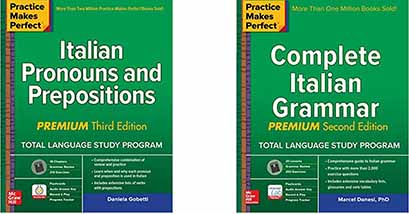
Rimbocchiamoci le maniche e impariamo i pronomi italiani!
Let’s roll up our sleeves and master Italian pronouns!
Un ripasso sui pronomi
A Review of Italian Pronouns
Rimbocchiamoci le maniche e alleniamo i nostri muscoli dei pronomi italiani! Questa settimana ho lavorato con diversi studenti per padroneggiare i pronomi (sì, Laura, sto parlando proprio di te!). Dato che sono immersa nelle spiegazioni, ho pensato che sarebbe divertente creare un post sui pronomi italiani, così tutti possono unirsi al divertimento!
Let’s roll up our sleeves and flex our Italian pronoun muscles! This week, I’ve been working with several students on mastering pronouns (yes, Laura, I’m talking about you!). Since I’m immersed in explanations, I thought it’d be fun to create a post about Italian pronouns so everyone can get in on the action!
Italian Pronouns: Your Linguistic Shortcuts
In just one word, you can say so much!
Direct pronouns, indirect pronouns, combined pronouns, and imperative pronouns are like magic tools—tiny yet powerful words that let you express yourself quickly and clearly in Italian.
Each type of pronoun serves a specific purpose, and understanding how to use them will transform your communication.
These are the Italian PRONOUNS
Subject pronouns
Reflexive pronouns
direct object pronouns
Indirect Object pronouns
combined direct and Indirect pronouns
Imperative combines pronouns

ITALIAN SUBJECT PRONOUNS
The subject pronoun is the person or thing doing the action in a sentence. As in these examples:
io
tu
lui, lei, Lei
noi
voi
loro
=
=
=
=
=
=
I
you
he, she, you (formal)
we
you (plural or y’all)
they
(Remember, the formal you (Lei) is the same as she (lei), except it’s capitalized.
Io lavoro a Milano.
I work in Milan.
Tu studi italiano.
You study Italian.
Lei va a scuola.
She goes to school.
Noi studiamo italiano.
We study Italian.
Voi abitate in Italia.
You all live in Italy.
Loro mangiano gli spaghetti.
They eat the spaghetti.
Having said that, Italian subject pronouns are usually dropped.
Why? Because you can tell who’s doing what from the verb ending.
Does that mean subject pronouns are never used?
Of course, not. They are still used to emphasize who is doing the action.
Lavoro a Milano.
I work in Milan.

ITALIAN REFLEXIVE PRONOUNS
Reflexive pronouns are used in conjunction with reflexive verbs.
The reflexive pronoun comes before the verb.
io
tu
lui, lei, Lei
noi
voi
loro
=
=
=
=
=
=
mi
ti
si
ci
vi
si
Note: when Italian reflexive verbs are in the infinitive form, you drop the -e at the end of the verb and add the correct reflexive pronoun. The reflexive pronoun must also agree with the person. the formal you (Lei) is the same as she (lei), except it’s capitalized.
Io mi chiamo Isabella de’ Medici.
My name is Isabella de’ Medici. (I call myself Isabella de’Medici.)
Tu ti addormento alle nove ogni sera.
You fall asleep every evening at nine-o-clock.
Lui si chiama Giuseppe Garabaldi.
His name is Giuseppe Garabaldi (He calls himself Giuseppe Garabaldi)
Ci sposiamo tra un mese.
We are getting married in a month (We marry ourselves within a month)
A che ora vi svegliate nella mattina?
At what time do you all wake up in the morning.
Si vedono nello specchio?
Do they see themselves in the mirror?

ITALIAN DIRECT OBJECT PRONOUNS
The direct object pronouns replace a direct object (like a book, a bike, a person).
This is equal to asking to whom? Or what? in English. The forms of the direct object pronouns,
with the exception of the third person singular and plural, are the same as the reflexive pronouns.
io
tu
lui
lei, Lei
noi
voi
loro (masculine objects)
loro (feminine objects)
=
=
=
=
=
=
=
=
mi
ti
lo
la
ci
vi
li
le
(Remember, the formal you (Lei) is the same as she (lei), except it’s capitalized.
Mi vedono.
They see me.
Ti amo.
I love you.
Il libro? Lo metto sulla scrivania.
The book? I put it on the desk.
Questa casa è bellissima. La compro.
This is a beautiful house. I’ll buy it.
Ci hanno invitato alla festa.
They invited us to the party.
Vi vedo al concerto.
I see you at the concert
I libri? Li leggo volentieri!
The books? I’ll happily read them!
Le scarpe? Le ho messe dentro l’armadio.
The shoes. I put them inside the closet.

ITALIAN INDIRECT OBJECT PRONOUNS
Verbs such as “regalare” (give a gift), dare (to give), or dire (to say), telefonare (to telephone),
piacere (to be pleasing) are followed the preposition by the preposition “a”
(the Italian preposition for “to”) when there is a connection to the object (an item or a person).
io
tu
lui
lei, Lei
noi
voi
loro
=
=
=
=
=
=
=
mi
ti
gli
le
ci
vi
gli or loro
Note: For third-person plural, there is only loro (them) or gli (them) regardless if the object or person is masculine or feminine. If Loro is written with a capital letter, then it refers to the plural, formal form of you.
Telefoniamo a Chiara domani.
We will call Chiara tomorrow.
Veramente regali a tuo fratello una macchina per il suo compleanno?
Really, you are giving your brother a car for his birthday?
The preposition “a” can be omitted when using such a verb together with an indirect object. This pronoun usually comes directly before the conjugated verb.
Mi danno un regalo.
They give me a gift.
Ti offre una bevanda.
She offers you a drink.
Gli dico la verità
I tell him the truth.
Le telefoniamo domani.
We will call her tomorrow.
Ci piace viaggiare in Italia.
We like traveling in Italy.
Posso chiedere Loro i documenti?
May I ask you both (plural) your identification papers?
Vi ho detto quello che penso.
I told you all what I think.
Posso chiedere Loro i documenti?
May I ask you both (plural) your identification papers?

ITALIAN COMBINED DIRECT AND INDIRECT PRONOUNS
Quick review of Direct Object pronouns: Direct Object Pronouns (la, la, li, le)
refer to a previously mentioned person or thing. They answer the question who or what?
Il computer? Lo trovi sulla scrivania.
The computer? You will find it on the desk.
Quick review of Indirect Object pronouns:
Indirect Object Pronouns (mi, ti, gli/le, ci, vi, gli/loro) generally answer the question to/for whom?
When direct and indirect object pronouns are combined:
the indirect pronouns mi, ti, ci, vi
become me, te, ce, ve.
Il computer…. Me lo dai?
The computer… will you give it [the computer] > [to me]?
Gli occhiali da sole? Te li ho prestati!
The sunglasses? I lent them [the sunglasses] > [to you].
L’auto… ce la presti?
The car… will you lend it [the car] … [to us.]
I biglietti… ve li spedisco?
The tickets… I’ll send them [the tickets] > [to you (plural)].
The negation “non” comes before the combined object pronouns.
L’appuntamento… non ce lo hanno dato.
The appointment… they didn’t give it [the appointment] > [to us].
Combined indirect and direct object pronouns
for Le and Gli become Glie
Gli do un libro. Glielo do.
I give him a book. I give it to him.
Le compro le collane. Gliele compro.
I buy her the necklaces. I buy her them.
Leggo una favola a mio figlio. Gliela leggo.
I read a story to my son. I read it to him.
Mando le email a Sara. Gliele mando.
I send the emails to Sara. I send them to her.
Regalo il fiore perfetto a mia madre. Glielo regalo.
I give the perfect flower to my mother. I give it to her.
Combined imperative indirect and direct object pronouns
Get bossy with combined imperative direct and indirect pronouns! This grammar structure I find particularly interesting not only because there is beauty in that so much can be quickly communicated in one word basically and because they are fun to say:
Dimmi! Dimmi qualcosa! Dimmelo!
Tell me! Tell me something! Tell me it!
Non dirgli! Non dirgli la verita! Non dirgliela!
Don’t tell him! Don’t tell him the truth! Don’t tell him it!
Mandami! Mandami la letter. Mandamela!
Send to me! Send to me the letter! Send it to me!
Mandiamogli! Mandiamogli la lettera! Mandiamogliela!
Send it to him! Send him the letter! Send it to him!
Dammi! Dammi il libro! Dammelo!
Give me! Give me the book! Give it to me!
Portami! Portami a casa! Portamela!
Take me! Take me home! Take me there (home)!
Che diavolo è un pronome, mi chiedi?
What the heck is a pronoun, you ask?

Stranamente, imparare l’italiano mi ha aiutato a capire meglio la grammatica inglese! Alle elementari probabilmente mi sono persa molto mentre sognavo ad occhi aperti, ma studiare l’italiano ha acceso una vera curiosità per il funzionamento della grammatica.
Funny enough, learning Italian helped me understand English grammar better! In grade school, I probably missed a lot while daydreaming, but studying Italian sparked a real curiosity about how grammar works.

I discovered a book called “English Grammar for Students of Italian” that was illuminating. It might interest you too. You can find it in my Amazon store along with other recommended language learning books.












